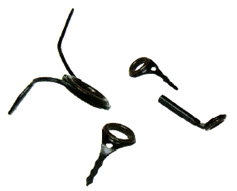Part 1 - Rods and Rings
|
Many of us know the satisfaction of catching a fish on a fly we’ve tied ourselves, so building our own rod is the next logical step. Anyone who can tie a fly should possess the necessary skills, and over the next few months I’m going to help you build a first-class 9ft four-section rod for a #5 line. To get started we need to choose the components and gather the materials and tools. Components
|
 |
Choosing a blank
Just like choosing a rod: what type of fishing, what action, what line weight, what length, and how many sections?
Blanks can be sourced relatively easily (see panel). Prices vary dramatically: a top-of-the-range American-made trout blank from a leading manufacturer will cost between £240 and £280, a first-class UK blank can retail for less than £50. Blanks are sold with an AFTM line weight rating. Remember that the AFTM number is only a guide. On testing your finished rod don't be surprised if you find you prefer a line lighter or heavier line than the rating; this simply reflects your casting style.
Choosing a set of rings
As a rule of thumb you will need one ring for every foot of rod plus a tip ring. More rings may help the line follow the bend more closely, but the extra weight can reduce the efficiency and performance of the finished rod.
Our chosen ring set is:
- 1 Hayfork type tip (Note: tip rings are fitted with a tube that must fit the diameter of the blank tip).
- 3 x #1 snake
- 3 x #2 snake
- 1 x #3 snake
- 1 x #4 snake
- 1 x Fuji #12 butt ring
- 1 x Keeper ring (optional)
Ideas on ring sizes differ - the argument is that large rings, especially at the butt, allow line to flow more easily. The down side is that they weigh more. Towards the butt, the weight of the rings and tyings has less effect on rod performance; towards the tip reducing the weight of ring, whipping and varnish to a minimum means the rod can recover as efficiently as possible.
Most modern fly rods are fitted with hard chrome snakes; these come either as bright chrome or with a variety of coatings: some coatings are simply cosmetic; some may make the metal harder or reduce friction.
American snakes are more common than British. Traditional British snakes have a slightly more rounded bore and hug closer to the blank, American snakes spiral the other way and stick out farther from the blank.
Double-leg snakes are more common, but single-leg rings are popular. There's little difference in weight between the two, but one less whipping does save a small amount of weight during the build. Single-legged rings are more prone to damage; they can get bent and can pull out of the single whipping.
Titanium alloy snakes, Recoil, by REC have recently become available. Lighter, thinner and much harder than conventional chrome snakes, they are also far more expensive and considerably more difficult to work with.
Hard chrome rings will wear over time - the most common sign is a slight groove in the rings nearest the tip - when casting you might feel that your line is not shooting as freely as it once did. Grooving is mostly caused by friction as old or dirty lines saw back and forth under tension: double-hauling makes matter worse. Worn rings will damage fly lines.
Some casters prefer to use a full set of lined rings because the ceramic lining is exceptionally hard and smooth and offers very low friction as the line slips over the ring surface. The down side again is weight; lined rings with an equivalent internal diameter tend to be heavier; that can be countered by using much smaller rings on the tip section(s). If you opt for lined rings, keep them as small as practical, bearing in mind that a fly line and knots must pass through easily.
